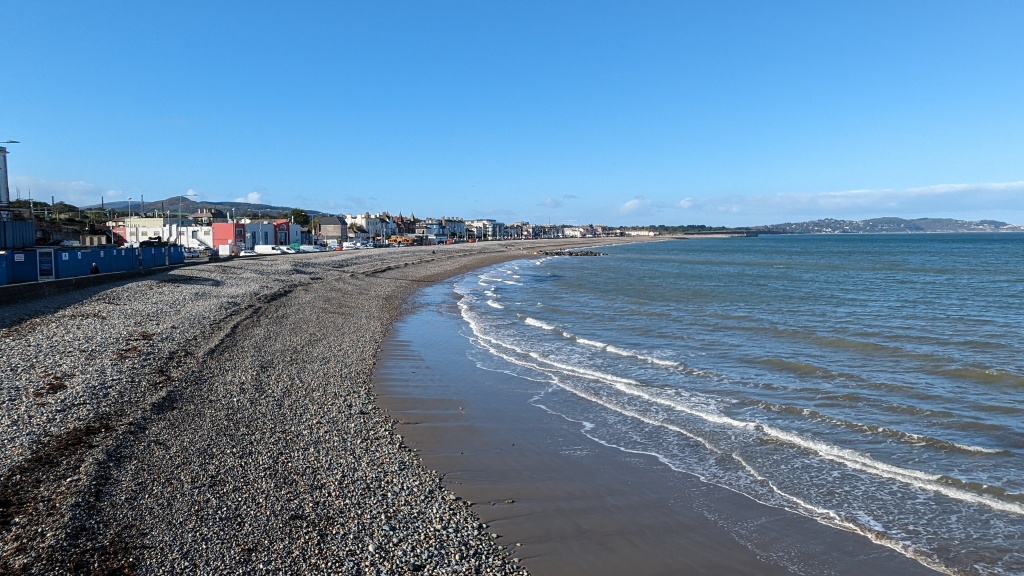The cold, stoney beaches of the east coast of Ireland are a part of Conal’s childhood. They are a far cry from the warm beaches of Australia that are Fran’s childhood.

By Conal Healy
Thursday, October 14, 2023 (7am): There is something magical, almost mystical, about watching the sun rise out of the sea. The slow transformation of the star-dotted sky from inky blackness, through orange pastels to bright golden to yellow and eventually blue, sky blue.
It was just before 7am. Fran and I were walking the long esplanade at Bray, County Wicklow, in Ireland, waiting for the sun to slip out of the Irish Sea. It was mid-October and the morning was “fresh” – cold, but not cold enough for a frost.
The previous day we had left the Wild West Way in Lahinch, County Clare, and driven cross-country to the east coast town of Bray.
This seaside town “buzzes with cafes and restaurants” and visitors are advised to enjoy panoramic views from Bray Head (which was closed, due to a landslide, when we visited).
In 2023, Bray has been listed as one of the world’s most “underrated travel destinations” by Time Out.
Visiting Bray on a Sunday was a regular outing for my family when I was growing up. My parents would pack us into the car for a day at the beach.
A “day at the beach” is a matter of geography. In Australia it usually means sunshine, heat, magnificent sandy beaches, warm water and waves to surf.
In Ireland, it can mean cloudy skies, coolness, a stiff breeze, a stony beach and a milk-pond flat sea which is grey in colour. The beach at nearby Greystones is well named – it consists of mainly grey stones.
Irish beaches bemuse Fran who spent her childhood on the gleaming white, sub-tropical, surf beaches of North NSW in Australia.
The beach at Bray is similar to its Greystones cousin in that is consists of stones, pebbles and a small margin of sand. When I walk across it, the sound under my shoes (not feet) reminds me of nails being dragged down a blackboard. The sound is grating.

At 7am, on a mid-autumn morning, with the temperature at single figures, neither Fran nor I were tempted to remove our layers of clothing to go for a dip in the “snot green and scrotum-tightening sea” (to borrow from James Joyce).
Our destination was to climb Bray Head and watch the sun rise out of the Irish Sea. A few days earlier, in Lahinch, we had watched the sun set into the North Atlantic Ocean. Bray was going to be a bookend.
Walking along the impressive Victorian seafront it was easy to imagine English army officers in full uniforms promenading with their lady friend on a sunny, summer’s afternoon. Maybe stopping to have an ice-cream. Or stopping to enjoy an afternoon tea?
The beachside promenade leads to a path up Bray Head (243 metres). We were told the view from the top is well worth climbing: it takes about half an hour, steep in parts, to the peak, marked by a huge wooden cross, but the panoramic views, north Wicklow and south Dublin, are well worth it.
Perfect for watching the sun rise!
We had just started our ascent (slipping quietly past the row of illegally pitched tents, homelessness is a real problem in Ireland) on the path of Bray Head when we greeted by a sign saying the path was closed.
The heavy rains of the previous Irish summer had caused a landslide blocking our route. So, no peak view.
Fran and I backtracked and found a (stoney) beach to sit and watch the sun rise.
On that cold, clear, cloud-free morning the sunrise was stunning. Yes, there was the slow transformation of the star-dotted sky from inky blackness, through orange pastels to bright golden to yellow and eventually blue. And yes, it was a sky-blue morning. It was magical. It was almost mystical.
It was the kind of day that made you want to go climb a mountain.
In fact, that is what we did … after a good cup of coffee.


Things about Bray
Bray is a coastal town in north County Wicklow, Ireland. It is situated about 20 km south of Dublin city centre on the east coast. It has a population of 33,512 making it the tenth largest urban area within Ireland (at the 2022 census).
Commuter links between Bray and Dublin are provided by rail, Dublin Bus and the M11 and M50 motorways. Parts of the town’s northern outskirts are in County Dublin.
Originally developed as a planned resort town in the 19th century, Bray’s popularity as a seaside resort was serviced by the Dublin and Kingstown Railway, which was extended to Bray in 1854.
During the late 20th century, the town’s use as a resort declined when foreign travel became an option for holiday-makers. However, day-trippers continued to come to Bray during the summer months.

Leave a comment